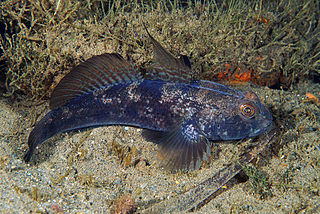
The black goby is a species of ray-finned fish found in the Eastern Atlantic and Mediterranean Sea and Black Sea. It inhabits estuaries, lagoons, and inshore water over seagrass and algae. It feeds on a variety of invertebrates and sometimes small fish. This species can also be found in the aquarium trade.

The rock goby is a small coastal goby of eastern Atlantic waters, from Scotland to Senegal. It is also reported from the Mediterranean and Black Seas, and is an anti-Lessepsian migrant in the Gulf of Eilat and Red Sea. There are unconfirmed records from the area around Pointe Noire in Congo-Brazzaville.
Risor ruber, the Tusked goby, is a species of goby native to reefs of the western Atlantic Ocean from southern Florida to the Bahamas and south to northern Brazil. This species associates with barrel sponges, sometimes living within the sponge. This species can reach a length of 2.5 centimetres (0.98 in) TL. It is currently the only known member of its genus.

Coryphopterus glaucofraenum, the bridled goby, is a species of goby native to the Western Atlantic Ocean and the Caribbean Sea from North Carolina to Brazil. It can be found on reefs at depths of from 2 to 45 metres in areas of white sand. This species can reach a length of 8 centimetres (3.1 in) TL. It occasionally makes its way into the aquarium trade.

Fries's goby is a species of goby native to the Eastern Atlantic Ocean along the coasts of Europe and northern Africa as well as the Mediterranean Sea to the Sea of Marmara. This species burrows into muddy or muddy sand substrates at depths of from 10 to 130 metres and is frequently found in association with the Norway lobster Nephrops norvegicus. This species can reach a length of 13 centimetres (5.1 in) TL. The specific name honours the Swedish zoologist Bengt Fredrik Fries (1799-1839).
Elacatinus chancei, the shortstripe goby, is a species of ray-finned fish in the family Gobiidae. It lives inside or on the surface of a sponge and occurs in tropical waters in the west central Atlantic Ocean, the Bahamas, the Antilles, and Venezuela.
Coryphopterus is a genus of gobies primarily found in the western Atlantic Ocean, although some species are found in the Indian and/or Pacific oceans.
Ginsburgellus novemlineatus, the Nineline goby, is a species of goby native to tropical reefs of the western Atlantic Ocean and the Caribbean Sea. It is frequently found associated with the sea urchin Echinometra lucunter, living underneath the urchin. This species grows to a length of 2.5 centimetres (0.98 in) TL. This species can also be found in the aquarium trade. This species is the only known member of its genus, the name of which honours the ichthyologist Isaac Ginsburg (1886-1975) of the U.S. National Museum who had an interest in gobies.

The Green banded goby, Tigrigobius multifasciatus, is a member of the goby family native to the western Atlantic ocean, from the Bahamas and Central America to northern South America. As the name implies, they are dark green with 17-23 pale green bars, and have a brown stripe through the eye interrupted with a bright red spot. It is believed by many that these markings imitate the Juvenile Schoolmaster Snapper.
Evermannichthys bicolor is a perciform species of fish in the family Gobiidae. As their name suggests, fishes in this species live inside sponges and can be found in the Caribbean Sea. The size of their populations are unknown, meaning it is not currently clear whether the bicolored sponge goby is in need of conservation.
Coryphopterus thrix, the bartail goby, is a species of goby found in the western Atlantic Ocean from southern Florida and the Bahamas to Brazil.
Coryphopterus alloides, the barfin goby, is a species of goby found in the western Atlantic Ocean from southern Florida and the Bahamas to Belize.

Coryphopterus dicrus, the Colon goby, is a species of goby found in the western Atlantic Ocean from southern Florida and the Bahamas to Brazil.

Coryphopterus eidolon, the pallid goby, is a species of goby found in the western Atlantic Ocean from southern Florida and the Bahamas to Brazil.

Coryphopterus hyalinus, the glass goby, is a species of goby found in the western Atlantic Ocean from Florida and the Bahamas to Central America and the Lesser Antilles.

Coryphopterus lipernes, the peppermint goby, is a species of goby found in the western Atlantic Ocean from Florida and the Bahamas to Central America and the Lesser Antilles.
Coryphopterus kuna, the Kuna goby, is a species of goby found in the western Atlantic Ocean along the coasts of Panama and Mexico.

Coryphopterus venezuelae is a species of goby found in the western Atlantic Ocean from Belize to Panama, the north coast of South America, Curaçao, Venezuela. It is also found in the Bahamas, the U.S. Virgin Islands, Puerto Rico, Saba, and Brazil.

Coryphopterus punctipectophorus, the spotted goby, is a species of goby found in the western Atlantic Ocean.

Coryphopterus personatus, the masked goby, is a species of goby found in the western-central Atlantic Ocean.













